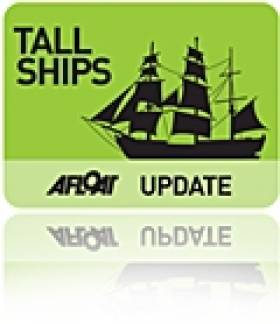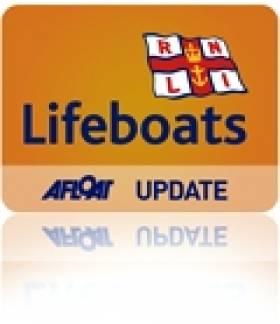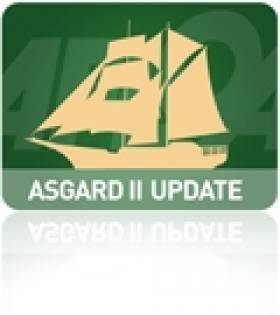Displaying items by tag: collision
#FERRY NEWS - The captain of the cargo ship Union Moon, who was arrested after his vessel collided with a passenger ferry in Belfast Lough, has been charged with 'excess alcohol by the master of a ship'.
BBC News reports that the 55-year-old was set to appear in court today, following his arrest yesterday.
No one was injured in the incident on Wednesday, when the Union Moon collided with the Stena Feronia close to the Fairway buoy between Carrickfergus and Helen's Bay. Both vessels were substantially damaged.
The cargo ship, which was carrying 2,000 tonnes of aggregate, was brought back to Belfast. Philip McNamara of the Donaghdee lifeboat confirmed that a large section of her bow was missing.
Meanwhile, engineers from Stena Irish Sea are assessing the damage to their vessel to determine how long it will be out of service. The Stena Feronia sails the route from Belfast to Birkenhead in Merseyside.
The Maritime and Coastguard Agency, the Marine Accident Investigation Branch and the PSNI are all involved in the investigation.
BBC News has more on the story HERE.
- Ferry news
- collision
- Belfast Lough
- cargo ship
- Union Moon
- captain
- charged
- drink
- excess alcohol
- ferry
- Stena Feronia
- Birkenhead
- Merseyside
- court
- Fairway buoy
- Carrickfergus
- Helen's Bay
- Philip McNamara
- Donaghdee
- Lifeboat
- Stena Irish Sea
- Maritime and Coastguard Agency
- Marine Accident Investigation Branch
- psni
Yacht Towed to Harbour after Collision with Tall Ship
The lifeboat launched at 2.38am and was on scene at 3.32am. Reports had been received from Dublin Coast Guard that the yacht was in urgent need of assistance after being damaged on collision with another vessel and was taking on water.
Arriving on scene the volunteer lifeboat crew saw debris in the water and noticed a considerable amount of damage to the yacht on the port side. They immediately assessed the state of the crew on both vessels, fifteen were onboard the Tall Ship and a single crewmember onboard the yacht.
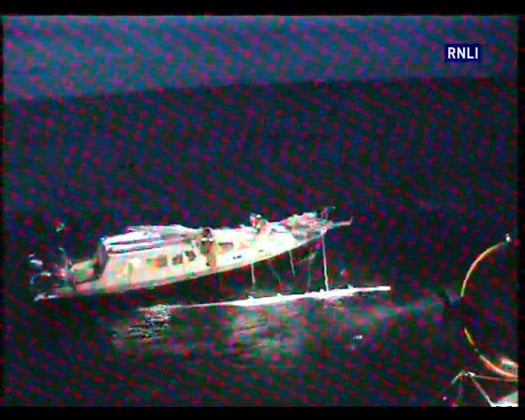
The casualty vessel - Photo: RNLI
On establishing there were no injuries three lifeboat crew boarded the yacht and cleared some of the debris from the water. Due to the damage the lifeboat crew took the yacht under tow back to Rosslare Harbour and the Tall ship made its way on to Waterford.
The Irish Coast Guard Helicopter from Waterford arrived on scene and provided a strong search light overhead for the crews to work in. Conditions were good with a slight swell.
Commenting on the callout, Rosslare Deputy Launching Authority Dave Maloney said, " While there was damage to one of the vessels thankfully there was no serious injury to any person. The priority for the lifeboat crews was to ensure that there was no danger to anyone and that the vessel was taken back to shore as quickly as possible due to the threat of sinking.”
Two Vessels Collide off Isle of Man
At 0600 this morning the 17-metre fishing boat 'Lynn Marie' called Liverpool Coastguard to report a collision between their vessel and the 155 metre coaster 'MV Philip'. Although there was minimal damage to the coaster, the fishing vessel suffered extensive damage to her port side bow and began taking on water. Liverpool Coastguard requested the launch of the Port St Mary RNLI Lifeboat, and other vessels in the area including the HM Customs Cutter 'Sentinel'.
Crew from the Port St Mary Lifeboat boarded the fishing vessel with their pump, along with a pump from the Sentinel, to try and stop it from taking on water. The Port Erin RNLI Lifeboat was also launched to provide an extra pump. The Port St Mary Lifeboat then towed the fishing vessel stern first (due to the damage) into the harbour at Port St Mary.
Liverpool Coastguard Watch Manager Su Daintith said:
"The fishing vessel Lynn Marie arrived alongside at Port St Mary at 0941 with the intention to tow her into the inner harbour at high water. The coaster MV Philip proceeded on to its original destination of Greenock.
We have informed the Marine Accident Investigation Branch of this incident."
Wicklow Boatyard at the Cutting Edge
Afloat magazine profiles Noonan Boats, one of the country’s leading repair facilities
From collision damage, keel fairing right up to osmosis treatments and re-sprays, Noonan boatyard in Newcastle, Greystones Co. Wicklow offers such a comprehensive service on the East Coast there is little need for any boat to go abroad for repairs these days, regardless of the extent of damage.
And news of the quality work has been spreading with boats from the four coasts Ireland coming to Wicklow for a range of work.
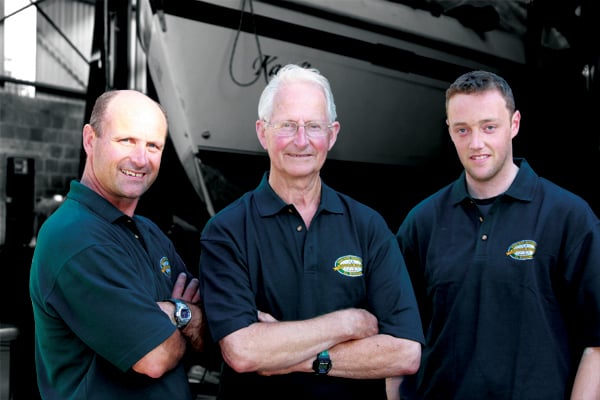
Graeme Noonan (left) has extensive big boat repair experience from his time in the marine industry in Sydney, Australia and is an active RS sailor. Founder Tony Noonan (centre) has spent a lifetime in the Irish Marine industry with Neil Watson Yachts, Wicklow Marine Services before setting up Noonan Boats in 1995. Brian Flahive is an active dinghy and keelboat sailor this year finished second in the Round Ireland double-handed class and won the Fireball National Championships.
Father and son team Tony and Graeme Noonan have over 30 years in the business and have recently expanded the premises to over 3,000 sq feet to cater for a growing range of repair work for boats up to 50 feet under cover.
They have a well-established reputation for the treatment of osmosis, to resolve hull blistering. This is a preventative and remedial process that requires specialist treatment.
The bulk of repair work comes from along the East Coast based boats and the nearby port of Dun Laoghaire but the company offers a national service to include transport to and from the Noonan boatyard if required.
“We have an established track record dealing with Insurance companies. No job is too difficult, too small or too big for us” says Tony Noonan.
Most work is carried out in in a purpose-built marine workshop containing two lifting bay facilities that includes keel and rudder repair pits but the firm also carries out on site repairs to suit too.
Repairs are carried out to original specifications and they carry out re-moulding repairs to up to date construction methods e.g. GRP foam core, Balsa core and carbon under vacuum bagging conditions.
A particular speciality is the repair of carbon repairs to dinghy masts, spinnaker poles and hulls. This has become more popular recently with the advent of carbon bowsprits on boats such as the J109s and SB3s.
Keel fairing, the process of improving the accuracy of the shape of a keel to improve boat speed is also high on the jobs list.
The company also has the specialist hot weld equipment to carry out the repair of polyethylene materials as used in the RS Feva and Laser Pico dinghies.
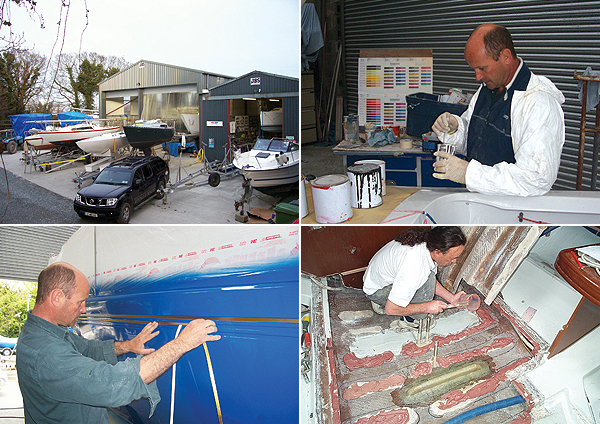
Colour Matching
Making a fibreglass repair to bring a boat back to original specification is one thing but matching gel coat to weathered or faded paintwork is quite another. Noonan Boatyard cosmetically match gels to present colour so the repair can appear practically invisible.
Polyethelene Repair
Plastic boats are durable but they can split and crack. Repairing them requires specialist heat gun welding equipment
Repair and re-spray
Weathered topsides, especially darker colours, always benefit from a re-spray, tired areas including decks and non-skid areas can also be re-sprayed
Floor matrix repair
After a keel grounding with rocks, for example, damage to a floor matrix may not be immediately visible but it is vital that inner frames are checked and repaired
Osmosis treatment, hot vac and copper coat
The yard uses the latest technology in the treatment of osmosis. Hulls are gel-planed to expose lay up prior to a HOT- VAC process and drying. This can be the stage where copper coat is an economical choice. It ends the need for the expensive and unpleasant annual chore of cleaning and repainting a boat’s hull. Simply hose down the hull at regular intervals, commonly once a year, to remove any build-up of sea-slime. We currently have two examples in our yard at present which show after one year and after ten years of immersion – and still working. Come and see for yourself!
Fully Repaired, Tried and Tested
Noonan Boats completed extensive repairs to Oystercatcher, a Gibsea 37, and when this work was completed the firm entered the boat in the gruelling 704-mile race round Ireland.
Local sailors Brian Flahive (Fireball National Champion) who works at the yard and Bryan Byrne manned what was Wicklow Sailing Club’s first ever yacht to entry into the doubled handed class of the Race. Dubbed the ‘Pride of Newcastle’ the entry finished an impressive winner of IRC III and Cruiser Class IV. The pair also finished second in the two handed class.
It was no easy journey but certainly the repairs stood up to the job, a case of repair work being tried, tested and proven!
The Boatyard, Sea Road, Newcastle, Greystones, Co. Wicklow
Tel/Fax: 01 281 9175 • Mobile: 086 170 8875
Email: [email protected]
- boats
- Wicklow
- RS Feva
- Dun Laoghaire
- Greystones
- collision
- Brian Flahive
- noonans boats
- wicklow boatyard
- boat repair
- keel fairing
- osmosis
- Newcastle
- Neil Watson
- Graeme Noonan
- Tony Noonan
- repair
- hull blistering
- Insurance
- lifting bay
- workshop
- GRP
- vacuum bagging
- carbon repairs
- dinghy masts
- spinnaker poles
- Laser Pico
- Polyethelene Repair
- respray
- Floor matrix
- hot vac
- copper coat
- Repaired
- damage
Collision with Submerged Container Most Likely Cause of Asgard II Sinking - Report
On 10th September 2008 the STV "Asgard II" departed Dournenez, France bound for La Rochelle, France with 5 crew and 20 trainee crew onboard. At approximately 01:00 hrs GMT on 11th September 2008 when off St. Nazaire in the Bay of Biscay water ingress was observed in the Trainee Mess. At 01:05 hrs a Pan Pan message was broadcast. At about 01:15 hrs a Mayday Relay message was received by French Search and Rescue (French SAR) as the water in the Trainee Mess continued rising rapidly. The crew attempted to pump the flood water without success.
The ship was abandoned by liferaft at approximately 01:50 hrs. Two French lifeboats rescued all 25 persons from the liferafts.
During the abandonment the floor of one of the three liferafts launched failed and the persons onboard were successfully transferred to the other liferafts. No loss of life occurred and there were no injuries reported.
Raise the Asgard - Afloat's 2008 online petition

